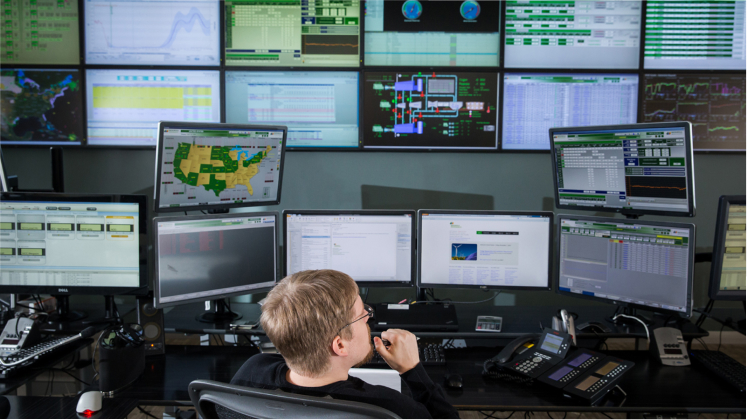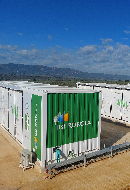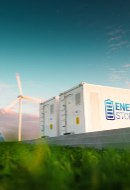¿Qué son los sistemas de gestión energética en empresas y cómo funcionan?
¿Qué es un sistema de gestión energética (SGE)?
Eficiencia energética Autoconsumo fotovoltaico Almacenamiento energético
Los sistemas de gestión energética (SGE) ayudan a las organizaciones a conocer su uso energético y optimizarlo a través de políticas y planes de acción cuyos objetivos son claros y medibles en el tiempo. La aplicación de esta metodología permite el ahorro energético, con su consiguiente ahorro económico, pero sobre todo acerca a las compañías a la consecución de sus objetivos de sostenibilidad a través de mejorar en el uso eficiente de la energía.

Aprovechar de manera óptima los recursos disponibles supone enormes beneficios y ahorros para organizaciones de todo tipo y tamaño. Desde un hogar familiar hasta una gran compañía con miles de empleados, si todos siguen un plan para apagar las luces cuando no están ocupando dicho espacio o desconectan aparatos de la red eléctrica cuando no son usados ya están contribuyendo a un uso más responsable de la electricidad. Esta es una pequeña parte de lo que podría contener un sistema de gestión energética.
Los SGEs son herramientas a disposición de las empresas (y también de particulares) para hacer un consumo energético más eficiente. A través de sistemas como el ciclo de Deming, también conocido como PDCA (Plan, Do, Check, Act en inglés, Planificar, Hacer, Verificar, Actuar, en su traducción al castellano), basados en la mejora continua, pueden establecer protocolos de acción cuyos resultados se miden y analizan dentro de un período de tiempo establecido. En base a su rendimiento, se evalúan para lanzar nuevas acciones que consigan mejorar su desempeño, de esta manera, se apuesta por un plan de acción que busca establecer objetivos cada vez más ambiciosos y las estrategias para lograrlos.
Etapas del ciclo de Deming
 VER INFOGRAFÍA: Etapas del ciclo de Deming [PDF]
VER INFOGRAFÍA: Etapas del ciclo de Deming [PDF]
En resumen, un SGE es un conjunto de estrategias que emplean diferentes tecnologías junto a la acción individual para obtener unos resultados enfocados en la optimización de los recursos energéticos de la empresa.
Beneficios de los sistemas de gestión energética para empresas
Para cualquier compañía, contar con un sistema de gestión energética debería ser igual de importante que cualquier otro plan de optimización de sus recursos o activos. Al hacerlo, no solo estarán dando un paso más hacia convertirse en una organización más sostenible, también conseguirán algunos beneficios directos y tangibles.
Tipos de tecnologías avanzadas para usar en un SGE
A la hora de trabajar en un sistema de gestión energética, es importante incorporar las tecnologías adecuadas para conseguir los objetivos propuestos. Con ellas, cualquier organización será capaz de obtener datos más precisos sobre su consumo, automatizar u optimizar los puntos más conflictivos y tomar decisiones mucho más informadas para que su plan sea un éxito.
Aplicación de la Certificación ISO 50001 en los SGE
La norma ISO 50001 se ha convertido en un marco de referencia para cualquier organización que desee implementar un sistema de gestión energética con éxito.
Se basa en una serie de recomendaciones estructuradas que tienen como eje central la metodología de mejora continua, por lo que suponen un esfuerzo constante y consciente por parte de las empresas que deseen implementar este estándar. Entre los beneficios de su uso están el cuidado proactivo del medioambiente al aplicar políticas de sostenibilidad y el consiguiente ahorro económico por la optimización del consumo energético.
¿Cómo certificar un sistema de gestión energética?
No existe una obligatoriedad a la hora de certificar un sistema de gestión energética, no obstante, seguir el marco de acción marcado por un estándar, por ejemplo, la ISO 50001, ofrece una guía clara sobre los pasos a seguir. Con esta referencia, el proceso es más claro y facilita la implementación dentro de la organización.
En el caso de la ISO 50001, la metodología en la que se basa es el ciclo de Deming, buscando un análisis constante que permita ir perfeccionando el plan creado. Para obtener la certificación, que tendrá una validez de tres años, el liderazgo en todas las capas de la empresa y el compromiso son puntos clave, desde la alta directiva hasta los puestos de menor responsabilidad.
De cara a la solicitud de la certificación, estos son los pasos a seguir:
 VER INFOGRÁFICO: Pasos recogidos en la ISO 50001 [PDF]
VER INFOGRÁFICO: Pasos recogidos en la ISO 50001 [PDF]
Tras la elaboración del plan, llega el momento de solicitar la certificación. Esto se debe llevar a cabo a través de certificadoras y auditoras externas a ISO, que evaluarán la idoneidad del sistema implementado a través de varias auditorías.
Tras ello, la entidad declarará si existen no conformidades en el plan y propondrá un plan de acciones correctivas que deberán llevarse a cabo para poder optar al ISO 50001. Una vez resultas las no conformidades, el sistema quedará certificado y recibirá un seguimiento periódico durante los tres años de validez establecidos para esta certificación oficial.

Sistemas de almacenamiento de energía en baterías (BESS)
Qué es y cómo funciona este tipo de almacenamiento en baterías.

Autosuficiencia energética
Los grandes retos de la independencia energética y cómo entra en juego la seguridad.

Qué es el almacenamiento energético
Claves sobre las tecnologías actuales y por qué son tan necesarias.
Retos y objetivos para la integración tecnológica
La incorporación de nuevos sistemas y tecnologías siempre es un reto para cualquier organización. Por un lado, está la curva de aprendizaje de todos los implicados y el grado de aceptación de los nuevos procesos; por otro, los costes asociados a la implementación de soluciones tecnológicas complejas y su integración dentro del sistema de trabajo.
A estos retos se suma la compatibilidad entre las distintas tecnologías (SCADA, EMS, IoT...) que deben funcionar en perfecta sintonía para que el plan establecido sea un éxito. Por tanto, estudiar bien la compatibilidad entre el hardware y el software que se desee emplear es esencial antes de poner en marcha las soluciones planteadas.
También se deben tener en cuenta durante la implementación de cualquier sistema de gestión energética cómo estos se integran con otros sistemas y planes operativos de la empresa. Por ejemplo, al introducir un nuevo stack tecnológico en la empresa que contendrá información sensible sobre la misma, deben estar en perfecta sintonía con los planes de seguridad y ciberseguridad para prevenir accesos indeseados y robo de datos por parte de terceros.
La elección de la tecnología está íntimamente ligada a los objetivos planteados y el punto de partida de cada entidad. Algunos de los que debe incluir un buen sistema de gestión energética son:
-
La interoperabilidad entre los distintos sistemas. La compatibilidad tecnológica entre las tecnologías empleadas actualmente y que se introducirán gracias al plan son esenciales para el éxito del mismo.
-
La eficiencia energética. Apostar por energías renovables y un sistema de autoconsumo, reducir el gasto habitual y contar con aparatos actuales y de bajo consumo en la medida de lo posible tiene que ser prioritario en cualquier SGE.
-
La sostenibilidad operativa de los cambios. Para que este sistema se integre con éxito en la empresa tiene que mantener o mejorar la operativa actual, favoreciendo el correcto desarrollo del negocio en el medio y largo plazo. No se trata de crear soluciones puntuales, sino soluciones sostenibles en el tiempo.
Sistemas de gestión energética en Iberdrola: casos de uso reales
En Iberdrola elegimos sistemas SCADA en nuestras operaciones para crear sistemas de gestión energética efectivos. Con ellos funcionan nuestros cuatro Centros de operación de Energías Renovables (CORE) y centrales hidroeléctricas (tenemos el COHI en España). A través de nuestra filial en el Reino Unido, ScottishPower Renewables, el Remote Control Center (RCC) de Iberdrola (Whitelee) supervisa en tiempo real el funcionamiento de los parques eólicos marinos y terrestres de la zona, donde trabajan para mantenerlos operativos el 97% del tiempo gracias al volumen de información con el que trabajan.
Nuestro CORE en Vancouver, el National Control Center, el Centro de Operación de Renovables de España ubicado en Toledo y el Centro de Operación de Renovables de Brasil que se encuentra en Río de Janeiro también trabajan aplicando este sistema.
Además, hemos implementado el INGECON HYDRO Manager en nuestras centrales minihidráulicas en España. Esta plataforma, desarrollada por Ingeteam, está basada en el sistema SCADA Ingesys IT y permite la supervisión, control y adquisición de datos de estas plataformas hidroeléctricas, siempre con el objetivo de mejorar la operatividad y la eficiencia en su uso.
Pero esta no es la única tecnología por la que apostamos en nuestros SGE. Las microrredes son un recurso que permite el acceso a energías renovables en zonas en las que sea un reto grande instalar la infraestructura habitual. De esta manera, garantizamos un acceso constante a energía sostenibles en espacios menos desarrollados. Un ejemplo de ello es el proyecto ‘Luz para todos’, gracias al cual inauguramos la primera microrred de Brasil con energía totalmente sostenible en 2023 desarrollada por nuestra filial en el país Neoenergía. Mediante este proyecto, aseguramos el suministro y almacenaje eficiente de energía a la comunidad de Xique-Xique, ubicada en el municipio de Remanso (Bahia).
























